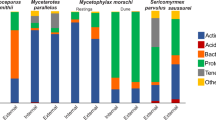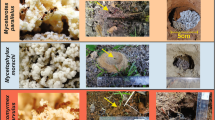Abstract
A comparative analysis of the abundance and biodiversity of actinomycete communities isolated from living ants Lasius niger and Formica cunicularia, as well as their anthills, has been carried out for the first time. The number of actinomycetes detected in L. niger ants is close to the number of actinomycetes in their anthills and one order is higher than that for F. cunicularia. Actinomycete communities of anthills and the intact soil are characterized by a high diversity, equitability, absence of severe dominants, and the presence of common species and differ by number and the range of species. Biodiversity of actinomycetes associated with living ants is considerably lower than in their nests and the surrounding soil and the range of actinomycetes is specific for both the species of ants.
Similar content being viewed by others
References
Jones, C.G., Lawton, H.J., and Shachak, M., Organisms as ecosystem engineers, Oikos, 1994, vol. 69, pp. 373–386.
de Bruyn, L.A., Grant, C.D., and Hulugale, N.E., The impact of ant bioturbation and foraging activities on surrounding soil properties, Dedobiologia, 2000, vol. 44, pp. 609–621.
Holec, M. and Frouz, J., The effect of two ant species Lasius niger and Lasius flavus on soil properties in two contrasting habitats, Eur. J. Soil. Biol., 2006, vol. 42, pp. 213–217.
Cammeraat, E.L.H. and Risch, A.C., The impact of ants on mineral soil properties and processes at different spatial scales, J. App. Entomol., 2008, vol. 132, pp. 285–294.
Frouz, J. and Jilkova, V., The effects of ants on soil properties and processes (Hymenoptera: Formicidae), Myrmecol. News, 2008, vol. 11, pp. 191–199.
Dlusskii, G.M., Murav’i roda Formica (Ants of the Genus Formica), Moscow: Nauka, 1967.
Czechowski, W., Radchnko, A., and Czechowska, W., The Ants of Poland: (Hymenoptera, Formicidae), Warzawa, 2002.
McCarthey, A.J. and Williams, S.T., Methods for studying the ecology of actinomycetes, Methods Microbiol., 1990, vol. 22, pp. 533–563.
Dauber, J., Schroeter, D., and Wolters, V., Species specific effects of ants on microbial activity and n-availability in the soils of an old-field, Eur. J. Soil Biol., 2001, vol. 37, pp. 259–261.
Boulton, A.M. and Amberman, K.D., How ant nests increase soil biota richness and abundance: a field experiment, Biodiv. Conserv., 2006, vol. 15, pp. 69–82.
Boots, B. and Ckopson, N., Linking ecosystem modification by the yellow meadow ant (Lasius flavus) to microbial assemblages in different soil environments, Eur. J. Soil. Biol., 2013, vol. 55, pp. 100–106.
Actinomycetes in Biotechnology, Goodfellow, M., Ed., Academic Press, 1988.
Shishov, L.L., Tonkonogov, V.D., Lebedeva, I.I., and Gerasimova, M.I., Klassifikatsiya i diagnostika pochv Rossii (Classification and Diagnosis of Russian Soil), Moscow: Pochv. Inst. im. V.V. Dokuchaeva, 2004.
Gauze, G.F., Preobrazhenskaya, T.P., Sveshnikova, M.A., Terekhova, L.P., and Maksimova, T.S., Opredelitel’ aktinomitsetov (Identification Guide to Actinomycetes), Moscow: Nauka, 1983.
Metody pochvennoi biologii i biokhimii (Methods of Soil Biology and Biochemistry) Zvyagintsev, D.G., Ed., Moscow: Mosk. Gos. Univ., 1991.
Lebedeva, N.V. and Krivolutskii, D.A., Biological diversity and methods for its assessment, in Geografiya i monitoring bioraznoobraziya (Geography and Biodiversity Monitoring), Moscow: Nauchn. Uchebno-Metod. Tsentr, 2002.
Zvyagintsev, D.G. and Zenova, G.M., Ekologiya aktinomitsetov (Ecology of Actinomycetes), Moscow: Geos, 2001.
Uitteker, R., Soobshchestva i ekosistemy (Communities and Ecosystems), Moscow: Progress, 1980.
Odum, E., Fundamentals of Ecology, Philadelphia: Saunders, 1971, 3d ed.
Magurran, A.E., Ecological Diversity and Its Measurement, London: Chapman and Hall, 1983.
Currie, C., A community of ants, fungi and bacteria: a multilateral approach to studying symbiosis, Annu. Rev. Microbiol., 2001, vol. 55, pp. 357–380.
Mirchink, T.G., Soil fungi as a component biogeocoenosis, in Pochvennye mikroorganizmy kak komponent biogeotsenoza (Soil Microorganisms as a Component of Biogeocoenosis), Moscow: Nauka, 1984.
Lyubarskii, E.L., On the procedure of rapid qualification and comparison of descriptions of Phytocenoses, in Kolichestvennye metody analiza rastitel’nosti (Quantitative Methods of Analysis of Vegetation), Ufa, 1974, pp. 221–224.
Author information
Authors and Affiliations
Corresponding author
Additional information
Original Russian Text © Yu.V. Zakalyukina, M.V. Golichenkov, O.I. Brovkina, T.S. Putyatina, 2014, published in Vestnik Moskovskogo Universiteta. Biologiya, 2014, No. 3, pp. 30–36.
About this article
Cite this article
Zakalyukina, Y.V., Golichenkov, M.V., Brovkina, O.I. et al. Comparative study of actinomycete communities associated with Lasius niger and Formica cunicularia ants and their nests. Moscow Univ. Biol.Sci. Bull. 69, 118–124 (2014). https://doi.org/10.3103/S0096392514030109
Received:
Published:
Issue Date:
DOI: https://doi.org/10.3103/S0096392514030109




